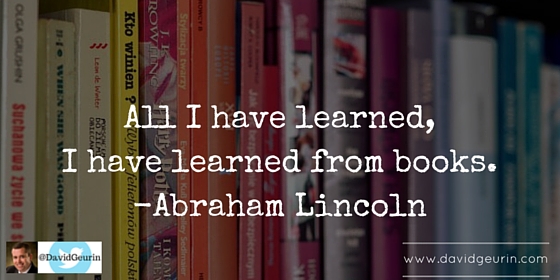In a previous post, I examined various benefits to sharing the good things happening in your classroom. I made the case that it is essential to share. When we make learning visible, it creates a stronger learning culture throughout the school. Sharing helps us learn from each other and creates opportunities for collaboration.
But I wanted to look at one more reason it's important to provide others with insights into the inner workings of your classroom.
Your work needs to be noticed. You deserve to feel appreciated.
Nearly every survey I've read on employee satisfaction shows that people want to feel respected and noticed for what they contribute in the workplace. Feeling appreciated is very important to work satisfaction. It's interesting to me that this is often ranked higher than salary, benefits, or opportunities for advancement.
I suspect educators are no different. We want to feel like we are making a difference, and it's great to have our efforts validated by people familiar with our work. You deserve to be noticed.
As principal, I realize how important it is to recognize the efforts of our staff. Honestly, I need to work at consistently doing this. Although I've done a variety of things to show appreciation, I also miss too many opportunities to do so. It's my sincere desire that my appreciation shines through even when I fail to be intentional in this area. I have great admiration and respect for the contributions of each member of our staff.
But here's something I've noticed. Because some teachers share more about what's happening in their classrooms than others, it's easier to be familiar with their work. Of course, I try to visit all classrooms regularly. But there's still so much that happens. A day in a high school with 800+ students is frenetic. And a principal's job is built for distraction.
More than once, I've learned of wonderful, dynamic, innovative learning in our building that might have gone unnoticed had I not accidentally learned about it. There are teachers who are quietly going about their work and doing a great job. They are amazing. But they are under the radar.
But I'm asking you to share. Please.
Your students deserve to get noticed. So does your classroom and so do you. Without a doubt, there are great things happening in your world of learning that need to get noticed. You give extra effort. You create improved opportunities for student learning. You have moments of awesomeness.
So teachers, share what's happening in your classroom. Advocate for your students. Reach out. Connect. Share. I'm suggesting you can contribute to your own sense of feeling appreciated by sharing and reflecting on your work.
Your principal wants to recognize your efforts (hopefully). And so do your colleagues (hopefully). A healthy school culture will see people getting genuinely excited about other people's successes.
And principals, be visible and available. Ask teachers what's happening in their classrooms. Ask what you can do to help. Give your teachers the confidence they need to share their work with you and others.
A person who feels appreciated will always do more than what is expected.
Question: How does your school create a culture of appreciation? I want to hear from you. Leave a comment below or respond on Twitter or Facebook.
But here's something I've noticed. Because some teachers share more about what's happening in their classrooms than others, it's easier to be familiar with their work. Of course, I try to visit all classrooms regularly. But there's still so much that happens. A day in a high school with 800+ students is frenetic. And a principal's job is built for distraction.
More than once, I've learned of wonderful, dynamic, innovative learning in our building that might have gone unnoticed had I not accidentally learned about it. There are teachers who are quietly going about their work and doing a great job. They are amazing. But they are under the radar.
But I'm asking you to share. Please.
Your students deserve to get noticed. So does your classroom and so do you. Without a doubt, there are great things happening in your world of learning that need to get noticed. You give extra effort. You create improved opportunities for student learning. You have moments of awesomeness.
So teachers, share what's happening in your classroom. Advocate for your students. Reach out. Connect. Share. I'm suggesting you can contribute to your own sense of feeling appreciated by sharing and reflecting on your work.
Your principal wants to recognize your efforts (hopefully). And so do your colleagues (hopefully). A healthy school culture will see people getting genuinely excited about other people's successes.
And principals, be visible and available. Ask teachers what's happening in their classrooms. Ask what you can do to help. Give your teachers the confidence they need to share their work with you and others.
A person who feels appreciated will always do more than what is expected.
Question: How does your school create a culture of appreciation? I want to hear from you. Leave a comment below or respond on Twitter or Facebook.








